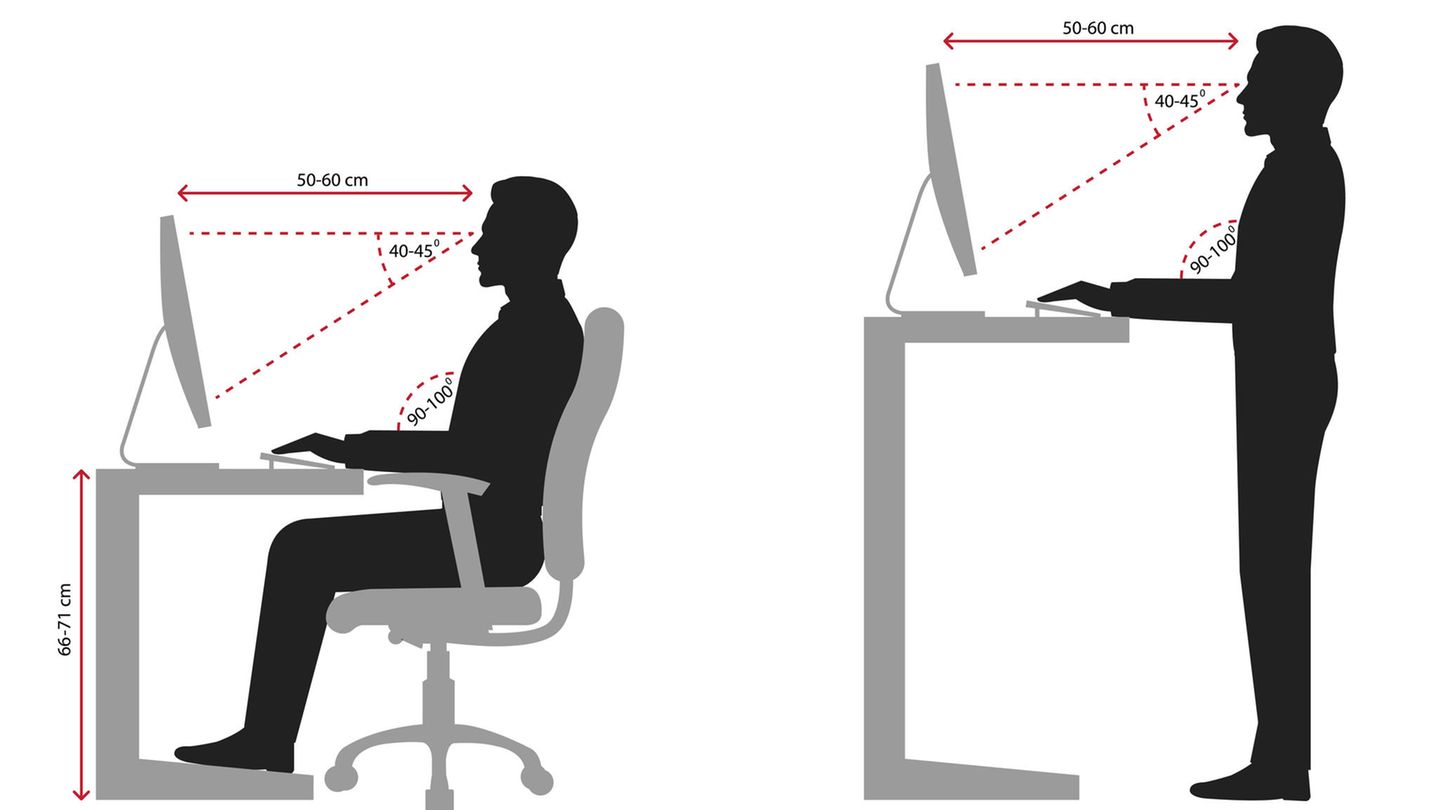Although our bodies are not suitable for long periods of sitting, we spend several hours at a desk every day without moving. The workplace should be ergonomically designed so that no physical complaints creep in.
According to a recent one, complaints of the musculoskeletal system such as back pain are still at the forefront of all types of illness: the health insurance company recorded an increase here compared to the previous year. The often work-related ailments are promoted by a lack of or even a lack of ergonomics in the workplace. This is particularly true in administrative professions – around 35 percent of employees complain of lower back pain, and more than 50 percent of problems with the neck. And that is by no means all the complaints that are caused by sitting incorrectly at the desk. In addition to those already mentioned, the most common symptoms include: Problems with the shoulder or wrist, as well as headaches and tension pains. The question arises as to how the workplace should look ergonomically correct so that you can prevent (further) work-related illnesses?
The desk
Many workers are satisfied with their desk even if it does not meet all of the criteria necessary for a healthy workplace. What most do not know: There are special guidelines for ergonomics in the workplace that every employer – from a purely legal point of view – has to adhere to. These include such and such: The preventive occupational health and safety should minimize work-related stress as far as possible in order to increase the well-being, motivation and the associated productivity of employees in the long term.
Since it has been proven that it is better to spend only two thirds of the working day sitting and one third of it standing the best choice. They enable the employee to work both sitting and standing – according to their own taste. This not only relieves the spine, but also the intervertebral discs. And these are both important factors for a healthy back. Ideally, the desk should be set so that it is between 66 and 71 centimeters high, measured from the floor, at least that is the optimal working height.
Furthermore, the desk should be at least 80 centimeters deep and 160 centimeters wide. However, the height and size of the surface are not the only criteria for an ergonomic workplace: The distance between the seat and the table is also important – it should not be more than 18 to 30 centimeters. You are sitting correctly when your forearms are horizontal on the desk and you have enough legroom under the plate so that you can also have one if necessary can accommodate. This is mainly used when the desk cannot be adjusted in height or is still too high even on the lowest level.
Another tip: If you already suffer from back problems, your family doctor will provide you with a prescription for the height-adjustable desk that you simply have to submit to your employer.
The office chair
This is at least as important for ergonomics in the workplace . Even if it is not cheap to buy, it still costs the employer less than a single day of sick leave. So that you can adjust it optimally to your needs, it must meet the following criteria: It should be height-adjustable and have a flexible or inclinable backrest that can be adjusted to your weight. The armrests are ideally also adjustable in height and the seat in depth. An additional inclination option for the seat is also recommended.
When the chair meets all of these factors, adjust it so that your upper and lower legs, as well as your upper and lower arms, are at right angles. The height must be adjusted so that the soles of your feet touch the entire floor and your forearms rest on the desk so that your shoulders are not pushed up. Here can be an additional be of great use if you have the feeling that you cannot implement the settings mentioned in the form. The best way to make sure you’ve done everything right is to bring in a colleague to check your posture.
The display
According to the VDU work regulation, the employer is obliged to assess the risk. In plain language this means: In every company, care must be taken at all VDU workstations that its employees are not at risk in terms of their safety and health protection. The requirements for the eyes as well as possible physical and psychological stress must therefore always be included in the assessment. You can read up on which guidelines must be complied with in detail.
When buying a new one you should make sure that it is flicker-free, has good contrast values, is at least 22 inches tall and has a high-resolution LCD display. Then set up the screen parallel to the keyboard and your shoulder axis. In addition, the upper part should be tilted slightly backwards – the upper edge of the monitor, on the other hand, must be a little below eye level. Because the fact is: Working on the screen is more relaxed for the eyes when the visual axis is tilted slightly downwards.
The light
Light also plays a decisive role in ergonomics at the workplace: the ideal lighting consists of a mixture of direct and indirect light, daylight and artificial light (e.g. a ) – in the best case, the artificial light sources can also be individually adjusted. As for the desk, the light should fall on it from the side and not be brighter than natural daylight. For this reason, the workstation must also be set up parallel to the window. This is the only way to achieve ideal lighting conditions.
The advantages
An ergonomic workplace may be associated with high costs, but every employer (and employee) should be aware that there are many advantages associated with it:
-
Every ergonomic measure is a preventive action. In other words: If the workplace is set up in such a way that typical occupational illnesses are prevented, the number of days absent for employees is reduced. In addition, the risk of accidents is minimized. In both cases, you save costs.
-
Many employees already suffer from chronic back or neck pain. Here, too, an ergonomic workplace can ensure that the discomfort is alleviated and the sense of well-being at the desk is increased. And that in turn ensures that further suffering is reduced.
-
Especially if employees are already aware of previous illnesses, it is imperative to design the workplace ergonomically. On the one hand you convey a feeling of appreciation to your employees, on the other hand you increase the productivity of your employees.
-
If employees feel that they are being taken seriously, the chances are very good that they will be retained by the company for a long time. Especially if the workplaces are designed in such a way that they are ergonomically correct with increasing age. Thanks to the positive association with your office, your employees will feel comfortable for many years.
Source From: Stern




